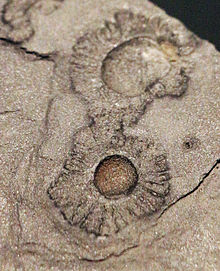Geology of Gabon
The Nyanga Basin and de-la-Noya in the western part of Gabon expose the Neoproterozoic West Congolian Supergroup, with deformed volcanic and sedimentary sequences, similar to others in southern Africa.
A horst from the Early Cretaceous splits the Lambarene-Chincoua basement rocks and divides the overlying western sedimentary basin in two.
[3] Gabon has the world's only site known to have self-sustaining natural nuclear fission, at the Oklo reactor zones near the town of Franceville in the Haut-Ogooué province.
Geologists noticed an unusually low concentration of uranium-235, leading to the current theory that the site was a natural nuclear reactor two billion years ago.
Half of the reactor zones lack carbonaceous material and in these locations, cesium, rubidium, strontium and boron escaped and were lost.
Some geologists have suggested that this natural bitumen encasement could be a way of storing human produced nuclear waste in permanent geologic disposal sites.
Geologists have identified other deposits such as tantalite, zinc, lead, dolomitic limestone, talc, potash and a variety of other materials.
